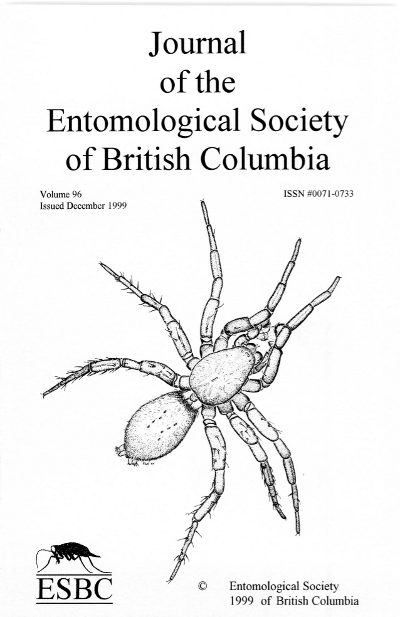Adult eclosion, flight and oviposition of Choristoneura rosaceana (Lepidoptera: Tortricidae), in British Columbia apple orchards
Abstract
Adult eclosion and oviposition of obliquebanded leafroller, Choristoneura rosaceana (Harris), was studied under field conditions so that integrated pest management of this species could be appropriately timed. Seasonal flight activity of adult males was monitored with synthetic pheromone-baited traps in unsprayed, organically grown apple, Malus domesticus (Borkh.) orchards in the Similkameen (1994-1997) and Okanagan (1996-1997) Valleys of British Columbia. Eclosion of adults from collected larvae and oviposition of female moths was monitored by daily observation in the 1996 and 1997 field seasons to establish relationships between insect phenology and accumulated degree days above 10°C (°ddlO°C) air temperature after 1 January. Males emerged before females throughout the eclosion period in both years. First catches of males in pheromone-baited traps preceded first-male eclosion of collected males by 7 and 6 °ddlO°C in 1996 and 1997, respectively, after which cumulative percentages of trap capture lagged behind cumulative percentages of male eclosion in both years. First and second male flight periods had similar durations in the Similkameen Valley, varying from 481-636 and 476-779 °ddlO°C, respectively. Mean (±SE) initiation of oviposition was 29 ± 2.2 °ddlO°C after the first female eclosed. The nonlinear relationships between plots of cumulative adult emergence, oviposition and trap catch against °dd10°C after I January were modelled using Weibull functions. Fifty percent adult eclosion was predicted to occur at 328 and 335 °dd10°C after 1 January for males and females in the overwintered gcneration, respectively. Fifty percent male and female eclosion in the summer generation was predicted to occur at 843 and 909 °dd10°C after 1 January. Fifty percent oviposition was predicted at 91 °dd10°C after first female emergence. Models of the trap catch in the Similkameen and Okanagan Valleys were similar and predicted 50% of the first flight at 438 (Similkameen) and 485 (Okanagan)°dd10°C after 1 January. Prediction of the occurrence of adult obliquebanded leafroller eclosion, mating and oviposition will aid in the developmcnt of a pheromone-based, integrated pest management programme for C. rosaceana in British Columbia.
Key words: Choristoneura rosaceana; phenology; mating; oviposition; pheromone
Downloads
Issue
Section
License
Authors who publish with the Journal of the Entomological Society of British Columbia agree to the following terms:
-Authors retain copyright and grant the journal right of first publication with the work simultaneously licensed under a Creative Commons Attribution License that allows others to share the work with an acknowledgement of the work's authorship and initial publication in this journal.
-Authors are able to enter into separate, additional contractual arrangements for the non-exclusive distribution of the journal's published version of the work (e.g., post it to an institutional repository or publish it in a book), with an acknowledgement of its initial publication in this journal.
-Authors are permitted and encouraged to post their work online (e.g., in institutional repositories or on their website) prior to and during the submission process, as it can lead to productive exchanges, as well as earlier and greater citation of published work (See The Effect of Open Access).


